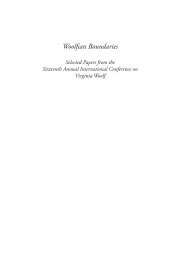Conference - Clemson University
Conference - Clemson University
Conference - Clemson University
You also want an ePaper? Increase the reach of your titles
YUMPU automatically turns print PDFs into web optimized ePapers that Google loves.
2<br />
Creative Inquiry Students Present Research at <strong>Conference</strong> (Continued from page 1)<br />
Students participating in Tissera’s Creative Inquiry projects, titled “The Hispanic World through Film, Literature, and Media” and “Health and<br />
Business Topics in Film and Media,” focus on comparative film analysis to explore topics related to the Hispanic world. They research diverse<br />
topics, such as the impact of immigration and civil wars on people and nations, medical conditions, alternate realities, arcane superstitions,<br />
and illegal trade, among others. They also investigate countries and their history and culture from different perspectives to present original<br />
ideas on social and political changes, health and business issues, cultural clashes, identity and survival and the search for meaning in life.<br />
In the panel, “Perspectives on Civil Wars and Survival in Film,” Thomas Cotton presented his paper “In the Eyes of War: Salvador and<br />
Machuca,” and Brooks Edwards presented “Representation of Survival in National Reorganization Processes through Argentinean Films.”<br />
In the “Exploring Cultures through Film” session, Jeremy Kincheloe reviewed his research on “Hispanic Children in the USA: Visual<br />
Learning, Filmic Portrayal,” Yahaira Aleman presented “The Long Journey to the Promised Eden in Maria Full of Grace and El Norte,” and<br />
Jessica Meehan reported on “The Paradox of Motherhood: Cinematic and Cultural Perspectives.” The students received competitive travel<br />
grants awarded by the Creative Inquiry Program to present their research.<br />
Through these Creative Inquiry studies, students have the opportunity to conduct serious research and contribute substantially to the field of<br />
text and film analysis. This invaluable experience allows students to develop critical thinking, teamwork and presentation skills, abilities that<br />
serve to enrich both their professional and personal lives.<br />
SEATJ participants included: (front row, from left) Leslie Williams, associate<br />
professor of Japanese and director of Language and International Trade, <strong>Clemson</strong><br />
<strong>University</strong>; Kaori Myashita-Theado, lecturer of Japanese, <strong>Clemson</strong> <strong>University</strong>;<br />
Kayo Omori, Japanese exchange student at <strong>Clemson</strong> from Fukui<br />
<strong>University</strong>; Mirano Nagamata, Spelman College; (back row, from left): Logan<br />
Reece, <strong>Clemson</strong> <strong>University</strong> alumnus; Toshiko Kishimoto, associate professor<br />
of Japanese, <strong>Clemson</strong> <strong>University</strong>; Yasu-Hiko Tohsaku, director of Japanese<br />
Language Program, <strong>University</strong> of California San Diego; Toshiko Calder,<br />
Princeton Saturday School; Xuexin Lui, associate professor of Japanese, Spelman<br />
College; Hideo Takada, KPMG, Atlanta; and Mariko Hata, Japanese exchange<br />
student at <strong>Clemson</strong> from Fukui <strong>University</strong>.<br />
SEATJ participants bow as they are introduced to<br />
keynote speaker Yasu-Hiko Tohsaku.<br />
<strong>Clemson</strong> Hosts Japanese Teachers’<br />
<strong>Conference</strong> (Continued from page 1)<br />
Yasu-Hiko Tohsaku, the first president of the newly organized<br />
American Association of Teachers of Japanese (AATJ) and<br />
professor at the <strong>University</strong> of California San Diego, was the<br />
keynote speaker. He presented “Japanese Language Education<br />
for the New Era.” Tohsaku is one of the top Japanese<br />
professors in the United States and wrote the first<br />
communicative-oriented Japanese textbook published in the<br />
United States. He is also well known for his lectures and<br />
advising in Japan, China and Korea.<br />
Toshiko Calder, chair of the Board of Directors of Princeton<br />
Saturday School, was the special guest speaker and outlined<br />
“The Present and Future of Heritage Japanese Language<br />
Education” in her presentation. An open forum titled<br />
“Student Learning Outcomes (SLO) and Articulation” was<br />
also featured. Members of the <strong>Clemson</strong> <strong>University</strong> Japanese<br />
Cultural Association (<strong>Clemson</strong>’s Japanese Club) served as<br />
volunteers to assist with conference set-up, registration and<br />
technical assistance.<br />
The 2012 conference is the third time that <strong>Clemson</strong> <strong>University</strong><br />
has had the honor of hosting the event. The conference was<br />
financially supported by the College of Architecture, Arts and<br />
Humanities, the Department of Languages, the Northeast<br />
Asia Council and the Japan Foundation. Toshiko Kishimoto,<br />
associate professor of Japanese at <strong>Clemson</strong> <strong>University</strong> and<br />
SEATJ 2012 coordinator, will be president of SEATJ during the<br />
2012-2013 academic year.
















